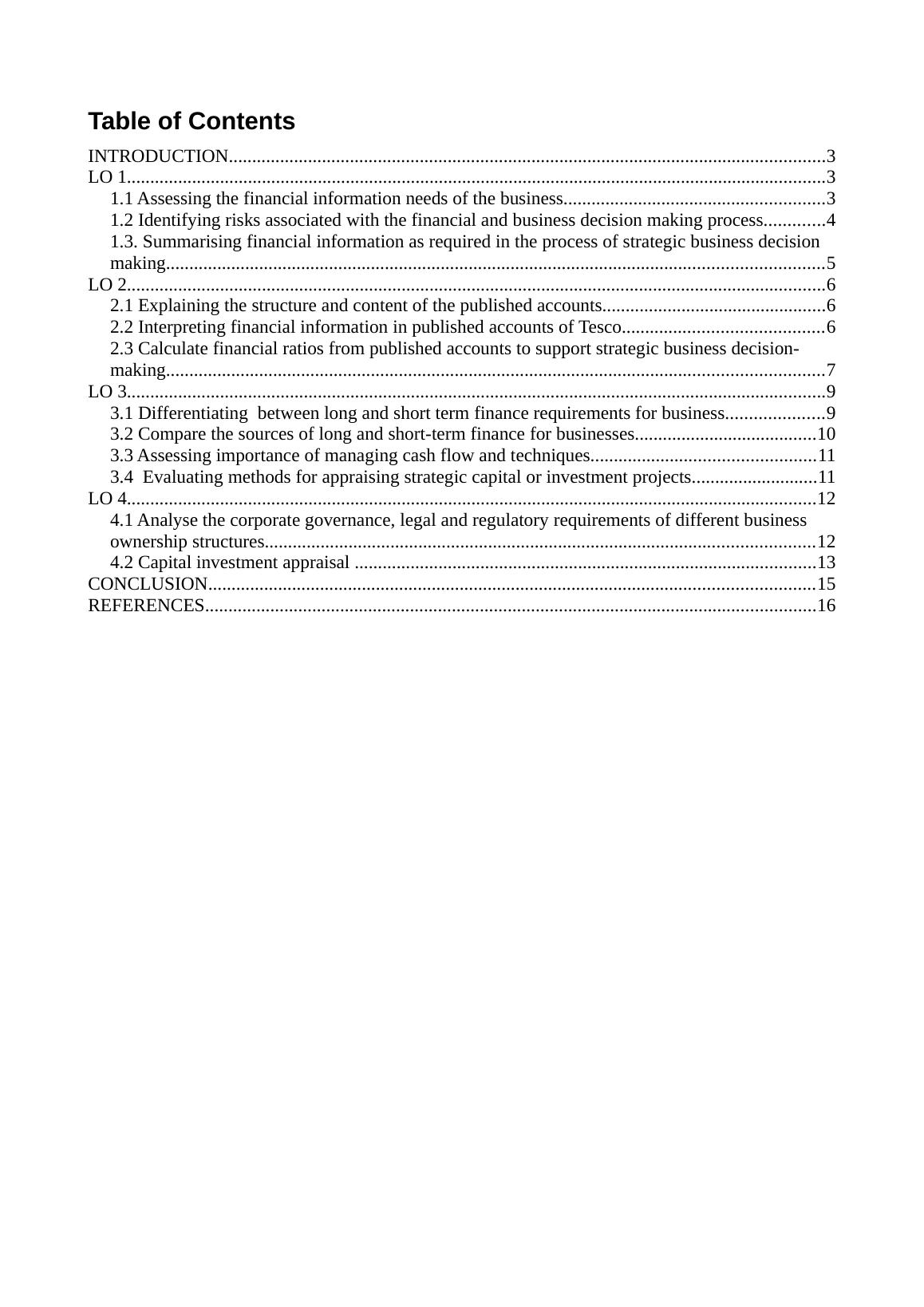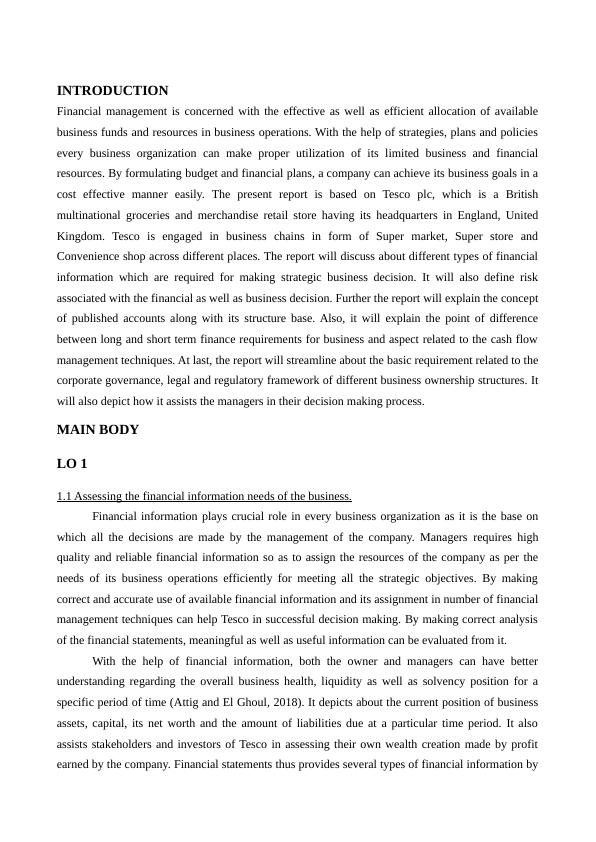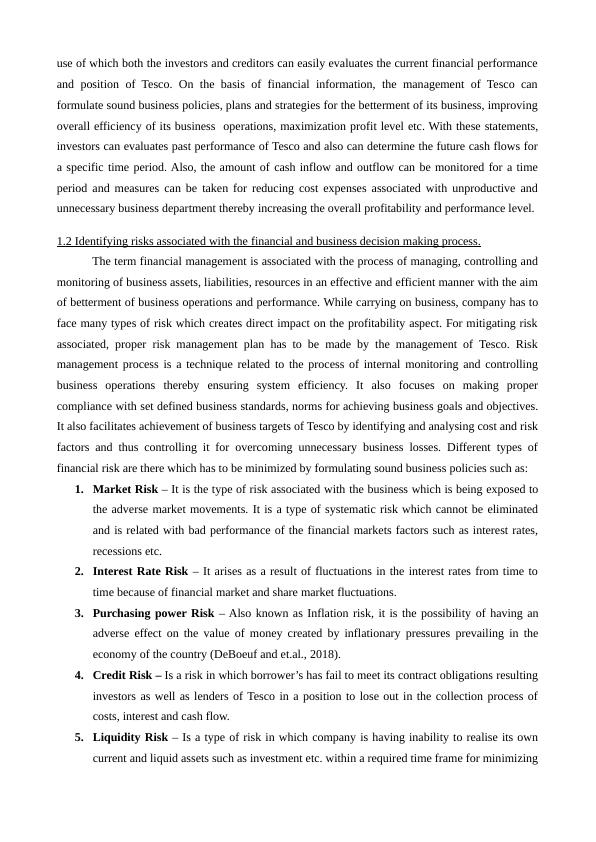Finance for Strategic Managers: Assignment
17 Pages5944 Words31 Views
Added on 2021-02-20
Finance for Strategic Managers: Assignment
Added on 2021-02-20
ShareRelated Documents
Finance for Strategic Managers

Table of Contents
INTRODUCTION................................................................................................................................3
LO 1......................................................................................................................................................3
1.1 Assessing the financial information needs of the business........................................................3
1.2 Identifying risks associated with the financial and business decision making process.............4
1.3. Summarising financial information as required in the process of strategic business decision
making.............................................................................................................................................5
LO 2......................................................................................................................................................6
2.1 Explaining the structure and content of the published accounts................................................6
2.2 Interpreting financial information in published accounts of Tesco...........................................6
2.3 Calculate financial ratios from published accounts to support strategic business decision-
making.............................................................................................................................................7
LO 3......................................................................................................................................................9
3.1 Differentiating between long and short term finance requirements for business.....................9
3.2 Compare the sources of long and short-term finance for businesses.......................................10
3.3 Assessing importance of managing cash flow and techniques................................................11
3.4 Evaluating methods for appraising strategic capital or investment projects...........................11
LO 4....................................................................................................................................................12
4.1 Analyse the corporate governance, legal and regulatory requirements of different business
ownership structures......................................................................................................................12
4.2 Capital investment appraisal ...................................................................................................13
CONCLUSION..................................................................................................................................15
REFERENCES...................................................................................................................................16
INTRODUCTION................................................................................................................................3
LO 1......................................................................................................................................................3
1.1 Assessing the financial information needs of the business........................................................3
1.2 Identifying risks associated with the financial and business decision making process.............4
1.3. Summarising financial information as required in the process of strategic business decision
making.............................................................................................................................................5
LO 2......................................................................................................................................................6
2.1 Explaining the structure and content of the published accounts................................................6
2.2 Interpreting financial information in published accounts of Tesco...........................................6
2.3 Calculate financial ratios from published accounts to support strategic business decision-
making.............................................................................................................................................7
LO 3......................................................................................................................................................9
3.1 Differentiating between long and short term finance requirements for business.....................9
3.2 Compare the sources of long and short-term finance for businesses.......................................10
3.3 Assessing importance of managing cash flow and techniques................................................11
3.4 Evaluating methods for appraising strategic capital or investment projects...........................11
LO 4....................................................................................................................................................12
4.1 Analyse the corporate governance, legal and regulatory requirements of different business
ownership structures......................................................................................................................12
4.2 Capital investment appraisal ...................................................................................................13
CONCLUSION..................................................................................................................................15
REFERENCES...................................................................................................................................16

INTRODUCTION
Financial management is concerned with the effective as well as efficient allocation of available
business funds and resources in business operations. With the help of strategies, plans and policies
every business organization can make proper utilization of its limited business and financial
resources. By formulating budget and financial plans, a company can achieve its business goals in a
cost effective manner easily. The present report is based on Tesco plc, which is a British
multinational groceries and merchandise retail store having its headquarters in England, United
Kingdom. Tesco is engaged in business chains in form of Super market, Super store and
Convenience shop across different places. The report will discuss about different types of financial
information which are required for making strategic business decision. It will also define risk
associated with the financial as well as business decision. Further the report will explain the concept
of published accounts along with its structure base. Also, it will explain the point of difference
between long and short term finance requirements for business and aspect related to the cash flow
management techniques. At last, the report will streamline about the basic requirement related to the
corporate governance, legal and regulatory framework of different business ownership structures. It
will also depict how it assists the managers in their decision making process.
MAIN BODY
LO 1
1.1 Assessing the financial information needs of the business.
Financial information plays crucial role in every business organization as it is the base on
which all the decisions are made by the management of the company. Managers requires high
quality and reliable financial information so as to assign the resources of the company as per the
needs of its business operations efficiently for meeting all the strategic objectives. By making
correct and accurate use of available financial information and its assignment in number of financial
management techniques can help Tesco in successful decision making. By making correct analysis
of the financial statements, meaningful as well as useful information can be evaluated from it.
With the help of financial information, both the owner and managers can have better
understanding regarding the overall business health, liquidity as well as solvency position for a
specific period of time (Attig and El Ghoul, 2018). It depicts about the current position of business
assets, capital, its net worth and the amount of liabilities due at a particular time period. It also
assists stakeholders and investors of Tesco in assessing their own wealth creation made by profit
earned by the company. Financial statements thus provides several types of financial information by
Financial management is concerned with the effective as well as efficient allocation of available
business funds and resources in business operations. With the help of strategies, plans and policies
every business organization can make proper utilization of its limited business and financial
resources. By formulating budget and financial plans, a company can achieve its business goals in a
cost effective manner easily. The present report is based on Tesco plc, which is a British
multinational groceries and merchandise retail store having its headquarters in England, United
Kingdom. Tesco is engaged in business chains in form of Super market, Super store and
Convenience shop across different places. The report will discuss about different types of financial
information which are required for making strategic business decision. It will also define risk
associated with the financial as well as business decision. Further the report will explain the concept
of published accounts along with its structure base. Also, it will explain the point of difference
between long and short term finance requirements for business and aspect related to the cash flow
management techniques. At last, the report will streamline about the basic requirement related to the
corporate governance, legal and regulatory framework of different business ownership structures. It
will also depict how it assists the managers in their decision making process.
MAIN BODY
LO 1
1.1 Assessing the financial information needs of the business.
Financial information plays crucial role in every business organization as it is the base on
which all the decisions are made by the management of the company. Managers requires high
quality and reliable financial information so as to assign the resources of the company as per the
needs of its business operations efficiently for meeting all the strategic objectives. By making
correct and accurate use of available financial information and its assignment in number of financial
management techniques can help Tesco in successful decision making. By making correct analysis
of the financial statements, meaningful as well as useful information can be evaluated from it.
With the help of financial information, both the owner and managers can have better
understanding regarding the overall business health, liquidity as well as solvency position for a
specific period of time (Attig and El Ghoul, 2018). It depicts about the current position of business
assets, capital, its net worth and the amount of liabilities due at a particular time period. It also
assists stakeholders and investors of Tesco in assessing their own wealth creation made by profit
earned by the company. Financial statements thus provides several types of financial information by

use of which both the investors and creditors can easily evaluates the current financial performance
and position of Tesco. On the basis of financial information, the management of Tesco can
formulate sound business policies, plans and strategies for the betterment of its business, improving
overall efficiency of its business operations, maximization profit level etc. With these statements,
investors can evaluates past performance of Tesco and also can determine the future cash flows for
a specific time period. Also, the amount of cash inflow and outflow can be monitored for a time
period and measures can be taken for reducing cost expenses associated with unproductive and
unnecessary business department thereby increasing the overall profitability and performance level.
1.2 Identifying risks associated with the financial and business decision making process.
The term financial management is associated with the process of managing, controlling and
monitoring of business assets, liabilities, resources in an effective and efficient manner with the aim
of betterment of business operations and performance. While carrying on business, company has to
face many types of risk which creates direct impact on the profitability aspect. For mitigating risk
associated, proper risk management plan has to be made by the management of Tesco. Risk
management process is a technique related to the process of internal monitoring and controlling
business operations thereby ensuring system efficiency. It also focuses on making proper
compliance with set defined business standards, norms for achieving business goals and objectives.
It also facilitates achievement of business targets of Tesco by identifying and analysing cost and risk
factors and thus controlling it for overcoming unnecessary business losses. Different types of
financial risk are there which has to be minimized by formulating sound business policies such as:
1. Market Risk – It is the type of risk associated with the business which is being exposed to
the adverse market movements. It is a type of systematic risk which cannot be eliminated
and is related with bad performance of the financial markets factors such as interest rates,
recessions etc.
2. Interest Rate Risk – It arises as a result of fluctuations in the interest rates from time to
time because of financial market and share market fluctuations.
3. Purchasing power Risk – Also known as Inflation risk, it is the possibility of having an
adverse effect on the value of money created by inflationary pressures prevailing in the
economy of the country (DeBoeuf and et.al., 2018).
4. Credit Risk – Is a risk in which borrower’s has fail to meet its contract obligations resulting
investors as well as lenders of Tesco in a position to lose out in the collection process of
costs, interest and cash flow.
5. Liquidity Risk – Is a type of risk in which company is having inability to realise its own
current and liquid assets such as investment etc. within a required time frame for minimizing
and position of Tesco. On the basis of financial information, the management of Tesco can
formulate sound business policies, plans and strategies for the betterment of its business, improving
overall efficiency of its business operations, maximization profit level etc. With these statements,
investors can evaluates past performance of Tesco and also can determine the future cash flows for
a specific time period. Also, the amount of cash inflow and outflow can be monitored for a time
period and measures can be taken for reducing cost expenses associated with unproductive and
unnecessary business department thereby increasing the overall profitability and performance level.
1.2 Identifying risks associated with the financial and business decision making process.
The term financial management is associated with the process of managing, controlling and
monitoring of business assets, liabilities, resources in an effective and efficient manner with the aim
of betterment of business operations and performance. While carrying on business, company has to
face many types of risk which creates direct impact on the profitability aspect. For mitigating risk
associated, proper risk management plan has to be made by the management of Tesco. Risk
management process is a technique related to the process of internal monitoring and controlling
business operations thereby ensuring system efficiency. It also focuses on making proper
compliance with set defined business standards, norms for achieving business goals and objectives.
It also facilitates achievement of business targets of Tesco by identifying and analysing cost and risk
factors and thus controlling it for overcoming unnecessary business losses. Different types of
financial risk are there which has to be minimized by formulating sound business policies such as:
1. Market Risk – It is the type of risk associated with the business which is being exposed to
the adverse market movements. It is a type of systematic risk which cannot be eliminated
and is related with bad performance of the financial markets factors such as interest rates,
recessions etc.
2. Interest Rate Risk – It arises as a result of fluctuations in the interest rates from time to
time because of financial market and share market fluctuations.
3. Purchasing power Risk – Also known as Inflation risk, it is the possibility of having an
adverse effect on the value of money created by inflationary pressures prevailing in the
economy of the country (DeBoeuf and et.al., 2018).
4. Credit Risk – Is a risk in which borrower’s has fail to meet its contract obligations resulting
investors as well as lenders of Tesco in a position to lose out in the collection process of
costs, interest and cash flow.
5. Liquidity Risk – Is a type of risk in which company is having inability to realise its own
current and liquid assets such as investment etc. within a required time frame for minimizing

End of preview
Want to access all the pages? Upload your documents or become a member.
Related Documents
(Doc) Finance for Strategic Managers - Assignmentlg...
|15
|4375
|30
FINANCE FOR STATEGIC MANAGERS TABLE OF CONTENTS INTRODUCTION 1 TASK 11 AC 1.1 Need of financial information for strategic business managerslg...
|16
|4137
|207
Finance for Strategic Managerslg...
|17
|5102
|433
Significance of Financial Management - Reportlg...
|17
|4261
|83
Finance for Strategic Managerslg...
|22
|5820
|50
Finance for Strategic Managerslg...
|13
|3482
|324
